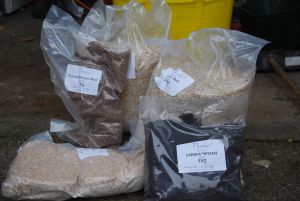I’d be surprised if anyone reading this wasn’t already well aware of what a fabulously sociable thing beer is (notwithstanding all those of us who quite enjoy a solo pint, as The Session a few months back proved!). Equally it is often remarked that the brewing industry is a pretty friendly world and that seems to be backed up by the various collaborations that seem to be getting more popular these days. So when an idea began to form (over a few beers, obviously) that myself, @MarbleTim and @ckdsaddlers could brew up a collaboration of our own, well it seemed perfect.
Of course, being a drunken idea, it was never going to be a simple affair. By the time we parted that evening we’d already settled upon a strong dark saison, which was to be aged in a wooden cask with a helping hand from a little Brettanomyces. A few days later and we’d added a fruity secondary fermentation on blackberries into the mix and from that point on we never looked back.
It wasn’t without its difficulties though. For starters we didn’t actually have a wooden cask, and it quickly became apparent that the only way we were going to get one small enough to be any use was to buy new – a second-hand wine or whisky barrel would have added flavour and complexity but at 55 gallons the size just isn’t practical. Eventually a nice new chestnut (less intensely woody than oak apparently) 30l cask was sourced and so we were well on track. But to fill a 30l cask you need at least 30l of beer. Actually you need more, as even over the course of a few months aging there’ll be evaporation – the whisky distiller’s angels’ share – and we really need to top that back up. And it felt wrong not to have something to bottle when the main batch went into the cask, so we could get an earlier idea of how it would turn out while we were waiting for the aged version to be ready.
So the target was 50l. Not a problem in theory, given that I’d already got the makings of a 100l brewery in progress. But that is the key point – in progress. Not finished. Still, nothing like a bit of incentive to get on with a job. A 60l fermenter complete with a cooling coil, was quickly ready but the real challenge was the mash tun. There was always the option of mashing twice in my tiny (by comparison) original mash tun, but this wasn’t an ideal solution and even with two mashes it was going to be a tight fit to get enough wort to end up with 50l strong enough to ferment out to around 7% ABV. Having decided that the only solution was to crack on and get the new mash tun finished, and realising that I needed to get off the fence and either make the last bits I needed or get them bought, I finally put my hand in my pocket and, despite some hiccups along the way, am glad I did. The insulation may have still been a work in progress on the morning of the brewday, but it did the job and a last minute reconfiguration of the plumbing work didn’t hurt either. There may have been more satisfaction about making every last bit of it myself, but if I’m really honest, in 12 months time I’d probably still be waiting to get around to it and instead I can now get on with brewing instead. Or rather, focus on finishing off all the other jobs that are still outstanding…
So, finally, as a result of that slightly drunken conversation back in July, on a cold and frosty morning last weekend we finally got to turn our plans into reality. By half past 9 the liquor tank was warming up nicely as Chris and Tim turned up raring to go, and so we quickly got underway.
Our planning over the previous months had seen the theme of “three” firmly embedding itself, not least in the chosen name of our brew, “Saison a Trois” (which should explain the regular appearance of that hashtag on Twitter recently!) and so we started off with preparing our grist made up of three different types of grain – barley, wheat and spelt, and before long were mashing in the largest grain bill that the Otherton brewery has faced to date. The mash was deliberately on the cool side to get a higher than normal level of fermentables – we wanted this to finish on the dry side, while the spelt will hopefully give an increased perception of body to avoid it being too thin.

The grain bill…

The start of the sparge saw the christening of the new sparge arm (see my previous post on that subject) which I’m pleased to report was a definite success, and before long we were collecting a lovely dark wort into the copper ready for the boil.
By this stage it was becoming apparent that, unlike some of my recent solo efforts, this was going to be a well organised brewday and we were able to relax with some tastings of the last two Otherton efforts – including a porter straight from the fermenter which needed to be emptied before the saison could go in – as well as some bottled treats that Chris and Tim brought along for the occasion.









